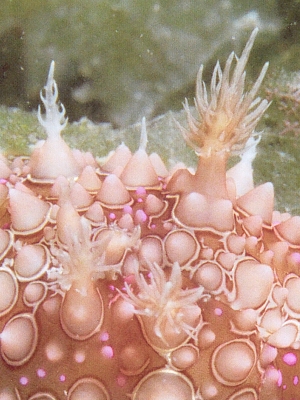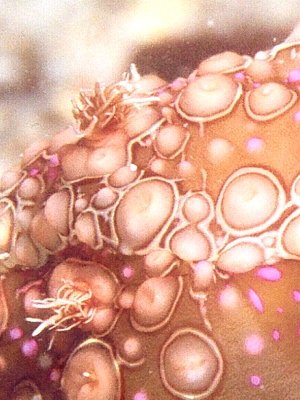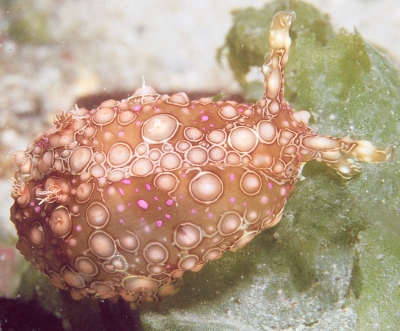Petalifera ramosa and its papillae
May 10, 2006
From: Leanne & David Atkinson

Dear Bill,
Thought this behaviour might be of interest. We found Petalifera ramosa on a soft green weed that is called locally sea lettuce. When we moved the weed to get a clearer photo of the Petalifera ramosa it withdrew the filamentous branches and terminal papillae into the tubercles just as some nudibranchs withdraw their gills into a gill pocket.
Locality: Fly Point, Marine Reserve, Port Stephens, 10 metres, New South Wales, Australia, Pacific, 5th November 2005, Sandy bottom scattered sponges, soft corals, ascidians and bryozoans. Length: 120mm. Photographer: Leanne & David Atkinson.
See photos attached of the same Petalifera ramosa before being disturbed and while the sea lettuce is being held in place by a black gloved finger in the bottom left corner, for the photograph. What is the purpose of the filamentous branches are they gills?
Regards,
Leanne & David Atkinson
atk@hunterlink.net.au



Dear Leanne & David,
Thanks for these photos which show the behaviour of the papillae so clearly. Although I don't think anyone has proved the papillae are secondary gills, the fact that they are filled with blood, and thin-walled, would suggest they are involved in gas exchange like a true gill. The body wall in most Sea Hares is quite thick and muscular so its unlikely that gas exchange can take place directly through the skin except in specialised 'thin' places like the papillae.
Many opisthobranchs have papillae and branching structures which are probably used as secondary gills. A secondary use for these structures is that they help camouflage the animal by breaking up its outline or silhouette and so make it less visible to likely predators. For example Tritoniopsis elegans looks spectacular and very obvious when photographed on a black background [see Fact Sheet] but in its natural environment it is almost invisible.
Best wishes,
Bill Rudman
Related messages
-
Re: Petalifera ramosa with probable eggs [2]
From: David and Leanne Atkinson, January 12, 2009 -
Re: Petalifera ramosa with probable eggs [1]
From: Leanne & David Atkinson, January 12, 2009 -
Re: Petalifera ramosa with probable eggs
From: Leanne & David Atkinson, February 1, 2008 -
Re: Petalifera ramosa with probable eggs
From: Leanne & David Atkinson, November 30, 2007 -
Petalifera ramosa with probable eggs
From: Ron Greer, November 29, 2007 -
Petalifera ramosa mating?
From: Leanne & David Atkinson, November 1, 2007 -
Petalifera ramosa from the Caribbean
From: Les Wilk, November 4, 2005 -
Petalifera ramosa from Port Stephens, NSW
From: Bruce Potter, November 2, 2005 -
Petalifera ramosa? from Eilat, Red Sea
From: Binyamin Koretz, May 11, 2005 -
Re: sea hare eggs
From: Binyamin Koretz, May 11, 2005 -
Petalifera ramosa from Saba,
From: Kelly Griggs, January 27, 2005 -
Petalifera ramosa from Bahamas
From: Lindsay Warren, March 23, 2004 -
Petalifera ramosa from Brunswick Heads
From: Denis Riek, December 19, 2003 -
Petalifera ramosa from Jamaica
From: Ross W. Gundersen, October 19, 2003 -
Petalifera ramosa from the Dominican Republic
From: Elianny Dominguez, May 17, 2003 -
Petalifera ramosa from the Caribbean
From: Bill Rudman, April 3, 2003 -
Petalifera ramosa from the Bahamas
From: Colin Redfern, April 2, 2003 -
Petalifera ramosa Baba from Japan
From: Jun Imamoto, February 5, 2003 -
Petalifera ramosa on Sea Grass
From: Erwin Koehler, February 8, 2001 -
Re: Petalifera from Pemba Island
From: Ron Velarde, February 7, 2001 -
Petalifera from Pemba Island
From: Bernard Picton, February 4, 2001 -
Petalifera ramosa from Lifou
From: Bill Rudman, February 4, 2001 -
Petalifera ramosa - additional images
From: Ron Greer, May 19, 2000 -
Re: Petalifera ramosa from New South Wales
From: Ron Greer, December 7, 1999 -
Petalifera ramosa from New South Wales
From: Ron Greer, December 3, 1999
